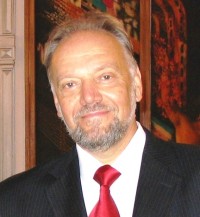Laboratory of Simulation and Supercomputer Technologies in Nuclear Physics and Power Engineering # 30
Head of laboratory
Dr. Leanid BABICHEU, PhD in Physics and Mathematics, Associate Professor
e-mail: babichev@sosny.bas-net.by
tel: +375 (17) 318-44-47, +375 (17) 375-83-79
Fax +375 (17) 374-83-35
History of Laboratory:
The laboratory was created in July 2012. The laboratory includes a sector that ensures the operation of the Institute’s Data Processing Center. The Data Center has the following equipment: K-500 supercomputer, IBM BladeCenter blade system consisting of 14 and 2-processor HS22 blade servers (156 computing cores), IBM System Storage N6040 storage system, network equipment. Computing resources and software enable full-scale precision Monte Carlo simulations of power reactor cores.
Main directions of scientific research:
- simulation of nuclear installations, justification of the safety of nuclear facilities at all stages of the life cycle;
- development of supercomputer and grid technologies for simulation in nuclear physics and high energy physics;
- research in the field of nuclear physics, particle physics and physics of interaction of radiation with matter;
- development of methods and means of information, analytical and computational support of work to ensure the safety of nuclear facilities.
The laboratory also carries out work on information support for the Institute’s activities, including:
— provides secure authorized remote access to stored information and computing resources;
— carries out construction, reconstruction, repair, development and technical re-equipment of the information and computing base, infrastructure facilities;
— carries out work on the design, development and operation of computer systems, including the use of information security tools.
International cooperation
The laboratory staff are part of the MPD collaboration, which unites 39 scientific organizations from different countries to conduct experiments on the Multi-Purpose Detector (MPD) — one of two specialized experiments on heavy ion collisions at the NICA heavy ion collider, one of the flagship projects of the Joint Institute for Nuclear Research (JINR, Dubna).
The laboratory participates in the following 4 R&D projects within the framework of the Coordination Plan for research work carried out at the Joint Institute for Nuclear Research (JINR) with the participation of organizations and institutions of the Republic of Belarus in 2024:
- Topic: 02-1-1065-1-2011/2025 “NICA Complex: Design and Construction of the Complex of Accelerators, Collider and Physics Experimental Facilities at Extracted and Colliding Ion Beams Aimed at Studying Dense Baryonic Matter and the Spin Structure of Nucleons and Light Ions, and at Carrying out Applied and Innovation Projects. MPD”. Project: “Analysis of observable quantities in heavy-ion collisions taking into account the parameters of the NICA accelerator.”
- Topic: 06-6-1118-1-2014/2030 “Multifunctional Information and Computing Complex (MICC)” Stage: “Study of the possibilities of using grid technologies and software for modeling and analyzing heavy-ion collisions at the NICA accelerator complex in the computing center of the JIPNR-Sosny State Scientific Institution”.
- Topic: 04-4-1149-1-2011/2028 “Development of the IBR-2 nuclear facility with a complex of cryogenic moderators”. Stage: “Study of the possibility of using precision neutron-physical codes used at JIPNR-Sosny to calculate the characteristics of neutron fields and their impact on structural materials outside the reactor core
- Topic: 04-4-1149-4-2021/2028 “New advanced neutron source at JINR”. Stage: “Application of spectral control of the core and calculation of neutron fluxes on the reactor vessel. Study of the effect of spectral control on fuel cycles and safety parameters for various types of reactors (thermal, intermediate and fast): WWER, WWER-SKD, BN and the pulsed fast reactor “Neptune”
Main publications
- Khrushchinsky, A., Kuten S., Babichev L. Datchik pryamogo zaryada s uluchshennoy dinamicheskoy kharakteristikoy [Self-Powered Neutron Detectors with improved dynamic response]. — London: LAMBERT Academic Publ., 2018, 84 p. — 84 p. — (in Russian)
- Babichev L. F., Rusak Yu. A., Rogachevsky O. V. Event-by-event analysis of heavy ion collisions with using a 3-uid dynamics model for MPD experiment // Nonlinear Dynamics and Applications: Proc. of 31th Int. Seminar «Nonlinear Phenomena in Complex Systems Minsk, Belarus, June 24–28, 2024 / Ed. by V. A. Shaparau, A. G. Trifonov. — Vol. 30. — Minsk: Pravo i Ekonomika Publ., 2024. — P. 1–9.
- Babichev L. F., Rusak Yu. A. Analysis of charged hadron yield distribution in Au+Au collisions using different parton energy loss models // Int. J. Nonlin. Phen. Compl. Syst. — 2022. — Vol. 25, no. 3. — P. 306–311
- Khrushchinsky A. A., Kuten S. A., Babichev L.F. Calculation of DPA for the VVER-1200 reactor vessel // Int. J. Nonlin. Phen. Compl. Syst. —2024. — Vol. 27, no. 2. — P. 194–198.
- Babichev L., Rudziankou I. Analysis of refueling of individual fuel assemblies in the reactor during one fuel campaign // Int. J. Nonlin. Phen. Compl. Syst. — 2023.— Vol. 26, no. 4. — P. 349–355.
- Babichev L. F., Rusak Yu. A. Monte Carlo simulation of phase transitions in heavy-ion collisions // Int. J. Nonlin. Phen. Compl. Syst. — 2023. — Vol. 26, no. 3. — P. 298–309.
- Rusak Yu. A., Babichev L. F. Monte-Carlo simulation of the 1st order hadron-QGP phase transition in heavy-ion collisions using parton model // Proceedings of NAS of Belarus. Physics and Mathematics Series. — 2020. — no. 1. — P. 84–91.
- Usheva K. I., Kuten S. A., Khruschinsky A. A., Babichev L. F. Generation of XS library for the reflector of VVER reactor core using Monte Carlo code Serpent // Journal of Physics: Conference Series. — 2017. — Vol. 781. — P. 012029(1–7).
- Babichev L. F. On the stability of the superconducting state in quasi-one-dimensional superconducting nanowires // Int. J. Nonlin. Phen. Compl. Syst. — 2016.— Vol. 19, no. 3. — P. 182–188.
- Babichev L. F., Khmialeuski A. N. Influence of metal shells around fuel assemblies on criticality calculations for a fuel storage pool // Int. J. Nonlin. Phen. Compl. Syst. — 2012. — Vol. 15, no. 3. — P. 305–308








